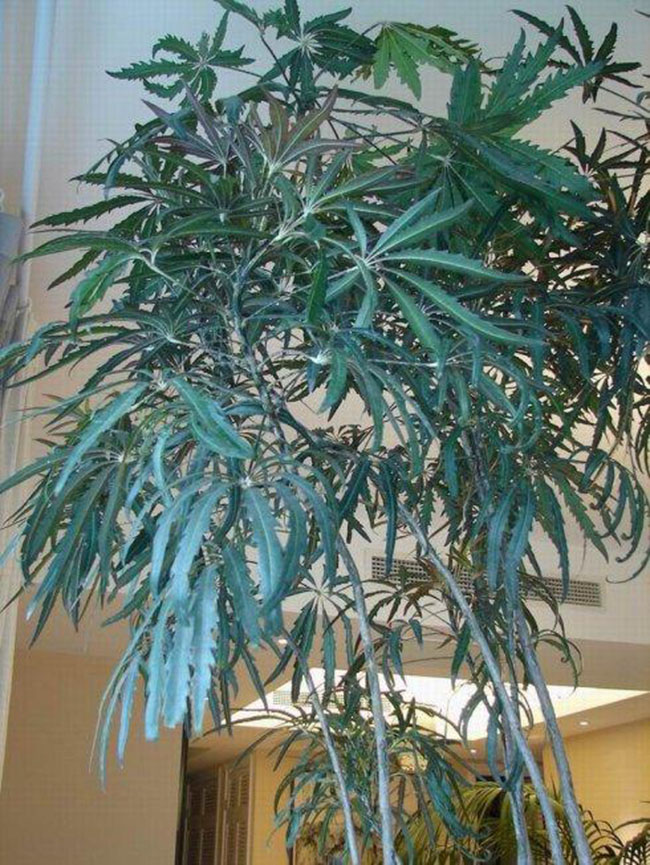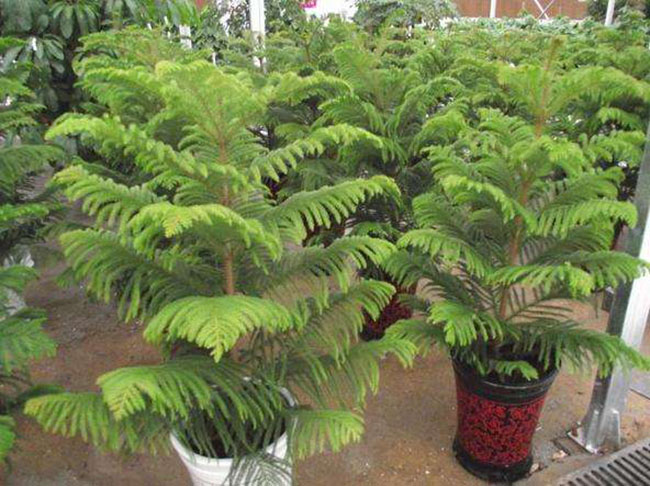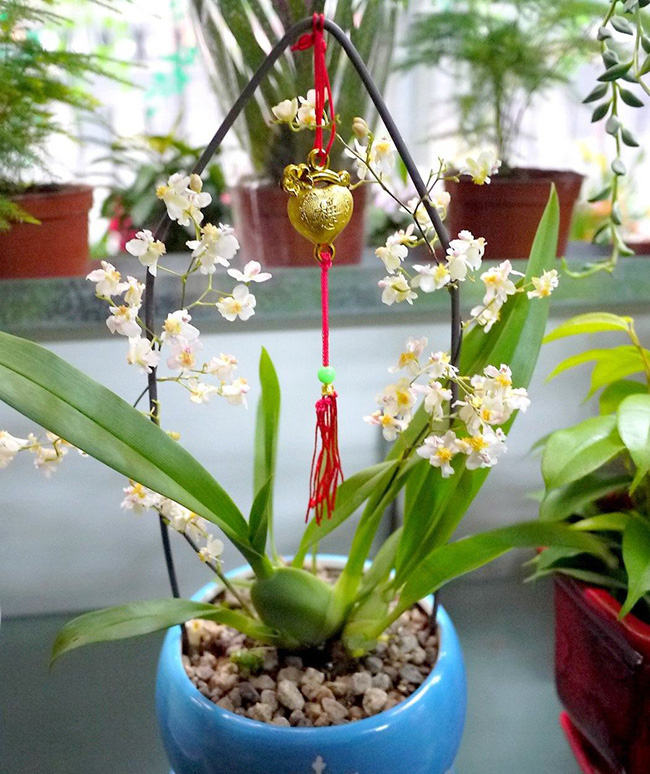Culture methods and matters needing attention of Peacock Wood
Peacock wood (Araliaceae) Peacock tree, also known as hand tree, belongs to the umbrella-shaped order, Araliaceae evergreen foliage small trees or shrubs. Native to Australia and the Pacific Islands. The leaf surface is leathery, dark green, resembling a slender finger, with a coarsely toothed leaf margin, radiating and staggered.

Morphological characteristics of malachite wood
Malachite is an evergreen foliage small tree or shrub, potted plants are often less than 2 meters. Tree trunks and petioles have milky spots. Leaves alternate, palmately compound, leaflets 7-11, strip-lanceolate, 7-15 cm long, 1-1.5 cm wide, margin serrated or pinnately divided, young leaves purplish red, then dark green. Leaf veins brown, total petiole slender. Compound umbels, arising in axils of stem top leaves, florets inconspicuous yellowish green.
Growing environment of malachite wood
Peacock wood like warm and humid environment, is a light-loving plant, not cold-resistant, not resistant to direct light. The soil should be rich and loose loam. Appropriate shade in summer, more sun in autumn and winter, the suitable temperature is 20 °C-29 °C. The temperature in winter should not be lower than 5 ℃, pay special attention to the temperature should not be high or low, otherwise the malachite is vulnerable to freezing damage.
Distribution range of malachite wood
Native to Australia and the Bologna Islands in the Pacific Ocean. It was introduced and cultivated earlier in South China, but now it is introduced as cultivated plants in many areas. It is also distributed in India, Sri Lanka and Indo-China Peninsula.
Main varieties of malachite wood
There are about 15 species of malachite in the same genus, and the common cultivated varieties are:
⑴ broad-leaved malachite:
Palmately compound leaves, 3-5 leaflets, broad leaves, variegated peacock wood, palmately compound leaves, dark green leaflets with yellow and white markings.
⑵ narrow-leaved malachite:
Also known as Vicki's false tree, hand tree, palmately compound leaves, shaped like palms, narrow and long leaflets, grayish green, dark red around the leaflets, middle rib pink.
Breeding mode of malachite wood
Sowing and reproduction
In some parts of South China, seedlings can be sown and raised. The seeds should be sowed in time after harvest, otherwise the seeds will lose their ability to germinate because of poor storage. The washed seeds can be stored in wet sand, and then sowed and sowed in spring after the cracks are exposed. The optimum temperature for seed germination is 20-25 ℃, and the seedlings can only emerge after 25-30 days of sowing. The germination rate will be seriously affected under the condition of low temperature. In addition, variegated leaf varieties are not suitable to raise seedlings by sowing.
Cuttage propagation
In the greenhouse, cutting propagation can be carried out in spring and autumn, but the productive cultivation is the best from May to June. The cutting substrate can be made of frogstone, perlite and peat soil, and rice bran ash can also be mixed with 2 parts of rice bran ash and 1 part of wet sand. Under the condition of electric hotbed, the cuttings were treated with 500mg/l indolebutyric acid or No. 1 ABT rooting powder for 5-10 s, and the rooting effect was better. The cuttings were 10-15cm long, cut off 1-2 leaves at the base, and inserted at a depth of about 1-2 of the ear length. After spraying water, the bamboo bow was set up, covered with film moisturizing, properly shaded, and rooting at a suitable temperature of 20 ~ 25 °C could be rooting in about 20 days.
Striping propagation
For the clustered plants planted in the ground, low pressure can be carried out in April: high pressure can be applied to the higher potted plants. Because of its thin stem, when carrying out high pressure, it is necessary to insert a bamboo pole as a pillar and tie the soil mass of the pressing part to the bamboo pole.
Culture methods of peacock wood
Temperature condition
Malachite likes warmth and is not cold-resistant. The suitable temperature for its growth is between 18 ℃ and 28 ℃. The overwintering temperature in winter should not be lower than 10 ℃. If the temperature is out of date in summer, it needs shading and spraying water to cool down. The weather is getting cooler in autumn, so you should move the peacock wood to a warm place indoors in time for the winter. After putting the peacock wood indoors, you should pay attention to the indoor temperature not to be hot and cold, which will make the plants freeze.
Light condition
Peacock wood likes plenty of light, but it is not resistant to direct sunlight. When planting malachite, malachite can be exposed to sufficient light in spring and autumn, and should be shaded slightly in summer to avoid direct light, which is not necessary in winter. We should pay attention to make the malachite wood come into contact with enough sunlight, otherwise it will make the plant grow too much and affect its appearance.
Water condition
Peacock wood likes a wet environment. There should be plenty of water in the spring and autumn, but watering should be dry and wet. To maintain a certain degree of air humidity, you need to often spray water to the leaves and all around the plant to avoid curling and falling off the leaves due to dry air. In winter, watering should be controlled when the temperature drops, and spraying can be used instead of watering.
Fertilizer condition
Malachite wood has a great demand for fertilizer. When breeding peacock wood, it is necessary to apply some compound fertilizer particles or mixed fertilizer and water during the growing period. In summer, when the temperature is higher than 30 ℃, fertilizer should be stopped, and after autumn, fertilizer should be slowly reduced. When the temperature drops below 10 ℃, fertilizer should be stopped.
Points for attention in malachite culture:
1. Proper shading in summer and more sun in autumn and winter. The suitable temperature is 20 °C-29 °C. The winter temperature is not lower than 5 ℃.
2. When the temperature is above 30 ℃, fertilizer should be suspended. To 10-13 °C, all forms of topdressing should be stopped. When the leaves are physiologically yellowed, 0.2% ferrous sulfate solution can be properly poured or sprayed.
3. Change the basin every two years as necessary.
4. Malachite wood is vulnerable to leaf spot and anthracnose, which can be controlled by spraying 500 times of 50% topazine wettable powder.
5. When the air is too dry, the leaves are easy to be damaged by shell insects, which should be checked in time, manually removed or sprayed with omethoate.
6. The trade in spring and summer is endangered by red spiders, so it is necessary to strengthen ventilation and early prevention.
Culture methods and matters needing attention of peacock wood
Temperature of culture method of peacock wood
Malachite likes warmth and is not cold-resistant. The suitable temperature for its growth is between 18 ℃ and 28 ℃. The overwintering temperature in winter should not be lower than 10 ℃. If the temperature is out of date in summer, it needs shading and spraying water to cool down. The weather is getting cooler in autumn, so you should move the peacock wood to a warm place indoors in time for the winter. After putting the peacock wood indoors, you should pay attention to the indoor temperature not to be hot and cold, which will make the plants freeze.
Light
Peacock wood likes plenty of light, but it is not resistant to direct sunlight. When planting malachite, malachite can be exposed to sufficient light in spring and autumn, and should be shaded slightly in summer to avoid direct light, which is not necessary in winter. We should pay attention to make the malachite wood come into contact with enough sunlight, otherwise it will make the plant grow too much and affect its appearance.
Moisture content
Peacock wood likes a wet environment. There should be plenty of water in the spring and autumn, but watering should be dry and wet. To maintain a certain degree of air humidity, you need to often spray water to the leaves and all around the plant to avoid curling and falling off the leaves due to dry air. In winter, watering should be controlled when the temperature drops, and spraying can be used instead of watering.
Fertilizer
Malachite wood has a great demand for fertilizer. When breeding peacock wood, it is necessary to apply some compound fertilizer particles or mixed fertilizer and water during the growing period. In summer, when the temperature is higher than 30 ℃, fertilizer should be stopped, and after autumn, fertilizer should be slowly reduced. When the temperature drops below 10 ℃, fertilizer should be stopped.
Matters needing attention in breeding peacock wood pruning
In order to promote the growth of peacock wood and adjust the plant type, it needs to be pruned frequently. It is also necessary to cut off the diseased, withered and rotten branches of the peacock wood.
Diseases and insect pests
Malachite is vulnerable to leaf spot disease and anthracnose. Shell insects also appear when the air is dry, and red spiders are easy to appear when spring and summer intersect.
Breeding methods and matters needing attention of malachite
Malachite wood has a very beautiful name, beautiful trees and leaves, palmately compound leaves, fuchsia, very elegant, very suitable for decorating homes and venues. How do you raise malachite? Next, let's take a look at the breeding methods and points for attention of malachite.
I. Culture methods of malachite wood
1. Soil: potted malachite, the culture soil should be mixed with rotten leaf soil, garden soil and river sand to keep loose and fertile. In order to improve the ornamental ability, 4 seedlings can be planted in each pot. When cultivating seedlings, the growing season in summer and autumn should be fully watered and foliar spraying.
2. Temperature: the suitable temperature for the growth of malachite is 18 ℃ 23 ℃, while the seedling needs a slightly higher temperature, especially in winter, the temperature had better not be lower than 15 ℃, the old tree can withstand the short-term low temperature of 5 ℃, and the lower the temperature is, it will suffer frost injury.
3. Lighting: usually give an appropriate amount of light, if the light is not enough, it is easy to cause the branches to grow and affect its ornamental value. It is not easy to shade too much in the process of production and cultivation, and it can be maintained in a bright place in the shed, but avoid strong light in summer. Keep it in the dark for a long time and replenish the light at the right time.
4. Watering: the amount of water for adult plants in the growing season should be suitable, and the basin soil should not be too dry or too wet. It is best to thoroughly water the basin soil when it is slightly dry, and master the principle of "dry and wet". Peacock wood likes to be wet, so it must be sprayed regularly throughout the year to keep it alive.
5. Fertilization: malachite can grow normally from early spring to late autumn, and thin pancake fertilizer and water can be applied every two weeks in the growing season. Slow growth in winter, proper water control, stop fertilization, increase its cold resistance.
II. Matters needing attention in malachite culture
In order to ensure the beauty and good growth of peacock wood, it is necessary to prune and change the basin in the process of breeding peacock wood. In general, the malachite changes its basin every two years, pruning mainly its withered branches and weak branches, and re-pruning the thin plants when their new leaves sprout.
Malachite wood is vulnerable to leaf spot disease and anthracnose and can be sprayed with 50% topiramine wettable powder 500 times. When the air is too dry, malachite wood is prone to insect damage to leaves, spring and summer transactions are harmed by red spiders, timely inspection and early control.
The above is the introduction of malachite breeding methods and matters needing attention. Malachite breeding is relatively simple. I hope the above content will be helpful to everyone.
- Prev

Culture methods and matters needing attention of Cryptomeria fortunei
Introduction of Cunninghamia lanceolata, trees, up to 60 to 70 meters in origin, DBH more than 1 meter, bark gray-brown or dark gray, thick, transversely lobed; large branches spreading or obliquely extended, young crown tower-shaped, old into a flat top, lateral branchlets dense, drooping, nearly pinnate arrangement. Cunninghamia lanceolata is not resistant to cold and avoid drought.
- Next

Culture methods and matters needing attention of Oncidium
Oncidium encyclopedia, also known as auspicious orchid, dance orchid, dance girl orchid, golden butterfly orchid, tumor orchid, etc., with 1 to 3 leaves, which can be divided into thin leaf species, thick leaf species and sword leaf species. Any of various plants of the genus Oncidium in the orchid family, with more than 750 native species in the world.
Related
- Fuxing push coffee new agricultural production and marketing class: lack of small-scale processing plants
- Jujube rice field leisure farm deep ploughing Yilan for five years to create a space for organic food and play
- Nongyu Farm-A trial of organic papaya for brave women with advanced technology
- Four points for attention in the prevention and control of diseases and insect pests of edible fungi
- How to add nutrient solution to Edible Fungi
- Is there any good way to control edible fungus mites?
- Open Inoculation Technology of Edible Fungi
- Is there any clever way to use fertilizer for edible fungus in winter?
- What agents are used to kill the pathogens of edible fungi in the mushroom shed?
- Rapid drying of Edible Fungi

